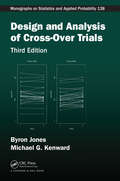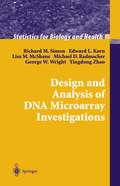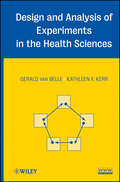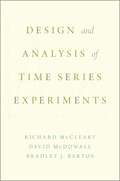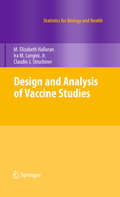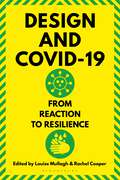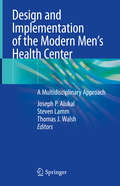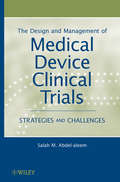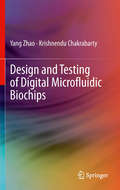- Table View
- List View
Design and Analysis of Cross-Over Trials (Chapman And Hall/crc Monographs On Statistics And Applied Probability Ser.)
by Byron Jones Michael G. KenwardDesign and Analysis of Cross-Over Trials is concerned with a specific kind of comparative trial known as the cross-over trial, in which subjects receive different sequences of treatments. Such trials are widely used in clinical and medical research, and in other diverse areas such as veterinary science, psychology, sports science, and agriculture.T
Design and Analysis of DNA Microarray Investigations (Statistics for Biology and Health)
by Richard M. Simon Edward L. Korn Lisa M. McShane Michael D. Radmacher George W. Wright Yingdong ZhaoThe analysis of gene expression profile data from DNA micorarray studies are discussed in this book. It provides a review of available methods and presents it in a manner that is intelligible to biologists. It offers an understanding of the design and analysis of experiments utilizing microarrays to benefit scientists. It includes an Appendix tutorial on the use of BRB-ArrayTools and step by step analyses of several major datasets using this software which is available from the National Cancer Institute.
Design and Analysis of Experiments in the Health Sciences
by Gerald van Belle Kathleen F. KerrAn accessible and practical approach to the design and analysis of experiments in the health sciences Design and Analysis of Experiments in the Health Sciences provides a balanced presentation of design and analysis issues relating to data in the health sciences and emphasizes new research areas, the crucial topic of clinical trials, and state-of-the- art applications. Advancing the idea that design drives analysis and analysis reveals the design, the book clearly explains how to apply design and analysis principles in animal, human, and laboratory experiments while illustrating topics with applications and examples from randomized clinical trials and the modern topic of microarrays. The authors outline the following five types of designs that form the basis of most experimental structures: Completely randomized designs Randomized block designs Factorial designs Multilevel experiments Repeated measures designs A related website features a wealth of data sets that are used throughout the book, allowing readers to work hands-on with the material. In addition, an extensive bibliography outlines additional resources for further study of the presented topics. Requiring only a basic background in statistics, Design and Analysis of Experiments in the Health Sciences is an excellent book for introductory courses on experimental design and analysis at the graduate level. The book also serves as a valuable resource for researchers in medicine, dentistry, nursing, epidemiology, statistical genetics, and public health.
Design and Analysis of Experiments in the Health Sciences
by Gerald van Belle Kathleen F. KerrAn accessible and practical approach to the design and analysis of experiments in the health sciences Design and Analysis of Experiments in the Health Sciences provides a balanced presentation of design and analysis issues relating to data in the health sciences and emphasizes new research areas, the crucial topic of clinical trials, and state-of-the- art applications. Advancing the idea that design drives analysis and analysis reveals the design, the book clearly explains how to apply design and analysis principles in animal, human, and laboratory experiments while illustrating topics with applications and examples from randomized clinical trials and the modern topic of microarrays. The authors outline the following five types of designs that form the basis of most experimental structures: Completely randomized designs Randomized block designs Factorial designs Multilevel experiments Repeated measures designs A related website features a wealth of data sets that are used throughout the book, allowing readers to work hands-on with the material. In addition, an extensive bibliography outlines additional resources for further study of the presented topics. Requiring only a basic background in statistics, Design and Analysis of Experiments in the Health Sciences is an excellent book for introductory courses on experimental design and analysis at the graduate level. The book also serves as a valuable resource for researchers in medicine, dentistry, nursing, epidemiology, statistical genetics, and public health.
Design and Analysis of Non-Inferiority Trials
by Mark D. Rothmann Brian L. Wiens Ivan S.F. ChanThe increased use of non-inferiority analysis has been accompanied by a proliferation of research on the design and analysis of non-inferiority studies. Using examples from real clinical trials, Design and Analysis of Non-Inferiority Trials brings together this body of research and confronts the issues involved in the design of a non-inferiority tr
Design and Analysis of Pragmatic Trials (Chapman & Hall/CRC Biostatistics Series)
by Song Zhang Chul Ahn Hong ZhuThis book begins with an introduction of pragmatic cluster randomized trials (PCTs) and reviews various pragmatic issues that need to be addressed by statisticians at the design stage. It discusses the advantages and disadvantages of each type of PCT, and provides sample size formulas, sensitivity analyses, and examples for sample size calculation. The generalized estimating equation (GEE) method will be employed to derive sample size formulas for various types of outcomes from the exponential family, including continuous, binary, and count variables. Experimental designs that have been frequently employed in PCTs will be discussed, including cluster randomized designs, matched-pair cluster randomized design, stratified cluster randomized design, stepped-wedge cluster randomized design, longitudinal cluster randomized design, and crossover cluster randomized design. It demonstrates that the GEE approach is flexible to accommodate pragmatic issues such as hierarchical correlation structures, different missing data patterns, randomly varying cluster sizes, etc. It has been reported that the GEE approach leads to under-estimated variance with limited numbers of clusters. The remedy for this limitation is investigated for the design of PCTs. This book can assist practitioners in the design of PCTs by providing a description of the advantages and disadvantages of various PCTs and sample size formulas that address various pragmatic issues, facilitating the proper implementation of PCTs to improve health care. It can also serve as a textbook for biostatistics students at the graduate level to enhance their knowledge or skill in clinical trial design. Key Features: Discuss the advantages and disadvantages of each type of PCTs, and provide sample size formulas, sensitivity analyses, and examples. Address an unmet need for guidance books on sample size calculations for PCTs; A wide variety of experimental designs adopted by PCTs are covered; The sample size solutions can be readily implemented due to the accommodation of common pragmatic issues encountered in real-world practice; Useful to both academic and industrial biostatisticians involved in clinical trial design; Can be used as a textbook for graduate students majoring in statistics and biostatistics.
Design and Analysis of Pragmatic Trials (Chapman & Hall/CRC Biostatistics Series)
by Song Zhang Chul Ahn Hong ZhuThis book begins with an introduction of pragmatic cluster randomized trials (PCTs) and reviews various pragmatic issues that need to be addressed by statisticians at the design stage. It discusses the advantages and disadvantages of each type of PCT, and provides sample size formulas, sensitivity analyses, and examples for sample size calculation. The generalized estimating equation (GEE) method will be employed to derive sample size formulas for various types of outcomes from the exponential family, including continuous, binary, and count variables. Experimental designs that have been frequently employed in PCTs will be discussed, including cluster randomized designs, matched-pair cluster randomized design, stratified cluster randomized design, stepped-wedge cluster randomized design, longitudinal cluster randomized design, and crossover cluster randomized design. It demonstrates that the GEE approach is flexible to accommodate pragmatic issues such as hierarchical correlation structures, different missing data patterns, randomly varying cluster sizes, etc. It has been reported that the GEE approach leads to under-estimated variance with limited numbers of clusters. The remedy for this limitation is investigated for the design of PCTs. This book can assist practitioners in the design of PCTs by providing a description of the advantages and disadvantages of various PCTs and sample size formulas that address various pragmatic issues, facilitating the proper implementation of PCTs to improve health care. It can also serve as a textbook for biostatistics students at the graduate level to enhance their knowledge or skill in clinical trial design. Key Features: Discuss the advantages and disadvantages of each type of PCTs, and provide sample size formulas, sensitivity analyses, and examples. Address an unmet need for guidance books on sample size calculations for PCTs; A wide variety of experimental designs adopted by PCTs are covered; The sample size solutions can be readily implemented due to the accommodation of common pragmatic issues encountered in real-world practice; Useful to both academic and industrial biostatisticians involved in clinical trial design; Can be used as a textbook for graduate students majoring in statistics and biostatistics.
Design and Analysis of Quality of Life Studies in Clinical Trials
by Diane L. FaircloughDesign Principles and Analysis Techniques for HRQoL Clinical TrialsSAS, R, and SPSS examples realistically show how to implement methods Focusing on longitudinal studies, Design and Analysis of Quality of Life Studies in Clinical Trials, Second Edition addresses design and analysis aspects in enough detail so that readers can apply statistical meth
Design and Analysis of Subgroups with Biopharmaceutical Applications (Emerging Topics in Statistics and Biostatistics)
by Naitee Ting Joseph C. Cappelleri Shuyen Ho Din Ding-Geng ChenThis book provides an overview of the theories and applications on subgroups in the biopharmaceutical industry. Drawing from a range of expert perspectives in academia and industry, this collection offers an overarching dialogue about recent advances in biopharmaceutical applications, novel statistical and methodological developments, and potential future directions.The volume covers topics in subgroups in clinical trial design; subgroup identification and personalized medicine; and general issues in subgroup analyses, including regulatory ones. Included chapters present current methods, theories, and case applications in the diverse field of subgroup application and analysis. Offering timely perspectives from a range of authoritative sources, the volume is designed to have wide appeal to professionals in the pharmaceutical industry and to graduate students and researchers in academe and government.
Design and Analysis of Time Series Experiments
by Richard McCleary David McDowall Bradley BartosDesign and Analysis of Time Series Experiments presents the elements of statistical time series analysis while also addressing recent developments in research design and causal modeling. A distinguishing feature of the book is its integration of design and analysis of time series experiments. Readers learn not only how-to skills but also the underlying rationales for design features and analytical methods. ARIMA algebra, Box-Jenkins-Tiao models and model-building strategies, forecasting, and Box-Tiao impact models are developed in separate chapters. The presentation of the models and model-building assumes only exposure to an introductory statistics course, with more difficult mathematical material relegated to appendices. Separate chapters cover threats to statistical conclusion validity, internal validity, construct validity, and external validity with an emphasis on how these threats arise in time series experiments. Design structures for controlling the threats are presented and illustrated through examples. The chapters on statistical conclusion validity and internal validity introduce Bayesian methods, counterfactual causality, and synthetic control group designs. Building on the earlier time series books by McCleary and McDowall, Design and Analysis of Time Series Experiments includes recent developments in modeling, and considers design issues in greater detail than does any existing work. Drawing examples from criminology, economics, education, pharmacology, public policy, program evaluation, public health, and psychology, the text is addressed to researchers and graduate students in a wide range of behavioral, biomedical and social sciences. It will appeal to those who want to conduct or interpret time series experiments, as well as to those interested in research designs for causal inference.
Design and Analysis of Vaccine Studies: (pdf) (Statistics for Biology and Health)
by M. Elizabeth Halloran Claudio J. Struchiner Ira M. Longini Jr.Design and Applications of Nanoparticles in Biomedical Imaging
by Jeff W.M. Bulte Michel M.J. ModoThis book covers the most recent advances in using nanoparticles for biomedical imaging, including magnetic resonance imaging (MRI), magnetic particle imaging (MPI), nuclear medicine, ultrasound (US) imaging, computed tomography (CT), and optical imaging. Topics include nanoparticles for MRI and MPI, siRNA delivery, theranostic nanoparticles for PET imaging of drug delivery, US nanoparticles for imaging drug delivery, inorganic nanoparticles for targeted CT imaging, and quantum dots for optical imaging. This book serves as a valuable resource for the fundamental science of diagnostic nanoparticles and their interactions with biological targets, providing a practical handbook for improved detection of disease and its clinical implementation.
Design and Covid-19: From Reaction to Resilience
by Louise Mullagh and Rachel CooperPresenting key examples and case studies of how design has responded to the pandemic, Design and Covid-19 offers lessons and approaches to design for future resilience. Design has a key role to play in not only creating products to ensure safety from the pandemic, but also in the creation of complex systems, new technologies and physical environments that enable us to carry out our lives and protect populations in the future. Design and Covid-19 identifies four key phases of the pandemic to examine how designers developed systems, services, communications and products as part of our response to the crisis, whether at an international, national or community level. Contributors report from a range of international contexts, including countries in Europe, Asia, Africa and Australasia, detailing how countries responded to the pandemic, introduced social distancing and lockdowns, developed test, track and trace systems, implemented new laws and how design and designers responded to the urgent new challenges that the pandemic created. They explore the adaptation of designs as communities searched for new ways of connecting and working through restrictions and social distancing measures, establishing local mutual aid groups and using social media to support each other through the pandemic, and go on to focus on recovery and resilience, analysing the deeper, systemic design response as industries emerge from lockdown. They explore the need to reflect on and investigate key issues in order to understand what we can learn personally, socially, economically and globally from this unprecedented crisis. Drawing upon the expertise of scholars from across the globe, Design and Covid-19 explores a wide range of design disciplines to address the complex societal and global issues highlighted throughout the pandemic, and to inform new ways of building human and planetary wellbeing.
Design and Covid-19: From Reaction to Resilience
Presenting key examples and case studies of how design has responded to the pandemic, Design and Covid-19 offers lessons and approaches to design for future resilience. Design has a key role to play in not only creating products to ensure safety from the pandemic, but also in the creation of complex systems, new technologies and physical environments that enable us to carry out our lives and protect populations in the future. Design and Covid-19 identifies four key phases of the pandemic to examine how designers developed systems, services, communications and products as part of our response to the crisis, whether at an international, national or community level. Contributors report from a range of international contexts, including countries in Europe, Asia, Africa and Australasia, detailing how countries responded to the pandemic, introduced social distancing and lockdowns, developed test, track and trace systems, implemented new laws and how design and designers responded to the urgent new challenges that the pandemic created. They explore the adaptation of designs as communities searched for new ways of connecting and working through restrictions and social distancing measures, establishing local mutual aid groups and using social media to support each other through the pandemic, and go on to focus on recovery and resilience, analysing the deeper, systemic design response as industries emerge from lockdown. They explore the need to reflect on and investigate key issues in order to understand what we can learn personally, socially, economically and globally from this unprecedented crisis. Drawing upon the expertise of scholars from across the globe, Design and Covid-19 explores a wide range of design disciplines to address the complex societal and global issues highlighted throughout the pandemic, and to inform new ways of building human and planetary wellbeing.
Design and Delivery of SiRNA Therapeutics (Methods in Molecular Biology #2282)
by Henrik J. Ditzel Martina Tuttolomondo Sakari KauppinenThis volume details protocols on rationale design of therapeutic siRNA molecules and its encapsulation with smart vehicles to overcome the barriers to an effective administration in vivo. Written in the highly successful Methods in Molecular Biology series format, chapters include introductions to their respective topics, lists of the necessary materials and reagents, step-by-step, readily reproducible laboratory protocols, and tips on troubleshooting and avoiding known pitfalls. Authoritative and cutting-edge, Design and Delivery of SiRNA Therapeutics aims to ensure successful results in the further study of this vital field.
Design and Development of Smart Surgical Assistant Technologies: A Case Study for Translational Sciences
by Jeff J.H. Kim Richard Um Rajiv R. Iyer Nicholas Theodore Amir ManbachiAre Amazon Alexa and Google Home limited to our bedrooms, or can they be used in hospitals? Do you envision a future where physicians work hand-in-hand with voice AI to revolutionize healthcare delivery? In the near future, clinical smart assistants will be able to automate many manual hospital tasks—and this will be only the beginning of the changes to come. Voice AI is the future of physician-machine interaction and this Focus book provides invaluable insight on its next frontier. It begins with a brief history and current implementations of voice-activated assistants and illustrates why clinical voice AI is at its inflection point. Next, it describes how the authors built the world’s first smart surgical assistant using an off-the-shelf smart home device, outlining the implementation process in the operating room. From quantitative metrics to surgeons’ feedback, the authors discuss the feasibility of this technology in the surgical setting. The book then provides an in-depth development guideline for engineers and clinicians desiring to develop their own smart surgical assistants. Lastly, the authors delve into their experiences in translating voice AI into the clinical setting and reflect on the challenges and merits of this pursuit. The world’s first smart surgical assistant has not only reduced surgical time but eliminated major touch points in the operating room, resulting in positive, significant implications for patient outcomes and surgery costs. From clinicians eager for insight on the next digital health revolution to developers interested in building the next clinical voice AI, this book offers a guide for both audiences.
Design and Development of Smart Surgical Assistant Technologies: A Case Study for Translational Sciences
by Jeff J.H. Kim Richard Um Rajiv R. Iyer Nicholas Theodore Amir ManbachiAre Amazon Alexa and Google Home limited to our bedrooms, or can they be used in hospitals? Do you envision a future where physicians work hand-in-hand with voice AI to revolutionize healthcare delivery? In the near future, clinical smart assistants will be able to automate many manual hospital tasks—and this will be only the beginning of the changes to come. Voice AI is the future of physician-machine interaction and this Focus book provides invaluable insight on its next frontier. It begins with a brief history and current implementations of voice-activated assistants and illustrates why clinical voice AI is at its inflection point. Next, it describes how the authors built the world’s first smart surgical assistant using an off-the-shelf smart home device, outlining the implementation process in the operating room. From quantitative metrics to surgeons’ feedback, the authors discuss the feasibility of this technology in the surgical setting. The book then provides an in-depth development guideline for engineers and clinicians desiring to develop their own smart surgical assistants. Lastly, the authors delve into their experiences in translating voice AI into the clinical setting and reflect on the challenges and merits of this pursuit. The world’s first smart surgical assistant has not only reduced surgical time but eliminated major touch points in the operating room, resulting in positive, significant implications for patient outcomes and surgery costs. From clinicians eager for insight on the next digital health revolution to developers interested in building the next clinical voice AI, this book offers a guide for both audiences.
Design and Evaluation of Plasmonic/Magnetic Au-MFe2O4 (Springer Theses)
by Ravichandran ManisekaranThis thesis documents the development of a multifunctional nanoparticle system to enhance the chemotherapeutic efficiency of anti-cancer drugs, and contributes to research that helps decrease the side-effects in cancer patients while simultaneously increasing their survival rates. The work begins with an introduction to nanomedicine and cancer therapy, and contains a literature review on magnetic, gold, and core-shell nanoparticles. It also covers synthesis techniques, properties, various surface modifications, and the importance of magnetic and gold nanoparticles. The author dedicates a chapter to characterization techniques, experimental setup, and cell cultivation techniques for in-vitro studies. Further chapters describe the background, characterizations, and applications of multifunctional magnetite coated gold core-shell nanoparticles, and the doping of cobalt to magnetite and manganese to magnetite nanoparticles. The important highlight of this research was the control of the size, shape, composition, and surface chemistry of nanoparticles.
Design and Implementation of the Modern Men’s Health Center: A Multidisciplinary Approach
by Joseph P. Alukal Steven Lamm Thomas J. WalshThis book outlines the approach to comprehensive men’s health deployed at three of the most successful American men’s health centers. It demonstrates the ways in which multidisciplinary care allows patients to easily access their doctors via coordination of care, same day add-on visits, and streamlining of office logistics such as sharing of charts, reports, and results. Guiding readers in establishing an evidence-based, multidisciplinary approach to the management of male patients of all ages, this volume shows how prevention, rapid intervention, cost efficiency, and coordinated care are at the forefront of a health center’s care strategy. The authors of this volume are thought leaders in the disciplines of cardiology, gastroenterology, dermatology, psychiatry, and preventative medicine.Design and Implementation of the Modern Men’s Health Center: A Multidisciplinary Approach enables urologists, medical subspecialists, and surgical subspecialists to both manage basic patient issues and also to understand how multidisciplinary care enables the success of a men’s health center.
The Design and Management of Medical Device Clinical Trials: Strategies and Challenges
by Salah M. Abdel-aleemClinical trials tasks and activities are widely diverse and require certain skill sets to both plan and execute. This book provides professionals in the field of clinical research with valuable information on the challenging issues of the design, execution, and management of clinical trials, and how to resolve these issues effectively. It discusses key obstacles such as challenges to patient recruitment, investigator and study site selection, and dealing with compliance issues. Through practical examples, professionals working with medical device clinical trials will discover the appropriate steps to take.
Design and Simulation in Biomedical Mechanics (Advanced Structured Materials #146)
by Juan Alfonso Beltrán-Fernández Andreas ÖchsnerThis book integrates bioengineering for solving health issues. It shows how the use of applied mechanics and strength of materials using 3D printing models, digital correlation techniques and computed tomography images, provides solutions to biology, medicine and mechanical engineering. The book provides clear processes and illustrations, several worked examples, and many projects. It helps scientists to analyze different modes of applying mechanical and biomedical concepts, physical principles to develop devices, sensors, prosthesis, orthotic systems, new materials and techniques that may improve the health system. It can be used in courses such as biomechanics and orthopedics, rehabilitation and mechanical engineering, also in rehabilitation or sports medicine.
Design and Testing of Digital Microfluidic Biochips
by Yang Zhao Krishnendu ChakrabartyThis book provides a comprehensive methodology for automated design, test and diagnosis, and use of robust, low-cost, and manufacturable digital microfluidic systems. It focuses on the development of a comprehensive CAD optimization framework for digital microfluidic biochips that unifies different design problems. With the increase in system complexity and integration levels, biochip designers can utilize the design methods described in this book to evaluate different design alternatives, and carry out design-space exploration to obtain the best design point.
Design and the Digital Divide: Insights from 40 Years in Computer Support for Older and Disabled People (Synthesis Lectures on Assistive, Rehabilitative, and Health-Preserving Technologies)
by Alan F. NewellDemographic trends and increasing support costs means that good design for older and disabled people is an economic necessity, as well as a moral imperative. Alan Newell has been described as "a visionary who stretches the imagination of all of us" and "truly ahead of his time." This monograph describes research ranging from developing communication systems for non-speaking and hearing-impaired people to technology to support older people, and addresses the particular challenges older people have with much modern technology. Alan recounts the insights gained from this research journey, and recommends a philosophy, and design practices, to reduce the "Digital Divide" between users of information technology and those who are excluded by the poor design of many current systems. How to create and lead interdisciplinary teams, and the practical and ethical challenges of working in clinically related fields are discussed. The concepts of "Ordinary and Extra-ordinary HCI", "User Sensitive Inclusive Design" , and "Design for Dynamic Diversity", and the use of "Creative Design" techniques are suggested as extensions of "User Centered" and "Universal Design." Also described are the use of professional theatre and other methods for raising designers' awareness of the challenges faced by older and disabled people, ways of engaging with these groups, and of ascertaining what they "want" rather than just what they "need." This monograph will give all Human Computer Interaction (HCI) practitioners and designers of both mainstream and specialized IT equipment much food for thought. Table of Contents: 40 years--Highlights and a Brief Review / Communication Systems for Non-Speaking and Hearing-Impaired People / TV Subtitling for Hearing-Impaired People / Word Prediction for Non-Speaking People and Systems for those with Dyslexia / Providing Reusable Conversation for Non-Speaking People / Story Telling and Emotion in Synthetic Speech / Lessons Learned from Designing AAC Devices / IT Systems for Older People / Designing IT Systems for Older People / Ordinary and Extra-Ordinary Human Computer Interaction / User Sensitive Inclusive Design / The Use of Professional Theatre / Attacking the Digital Divide
Design and Use of Assistive Technology: Social, Technical, Ethical, and Economic Challenges
by Meeko Mitsuko K. Oishi Ian M. Mitchell H. F. Machiel Van Der LoosDesign and Use of Assistive Technology assesses major hurdles in the design and use of assistive technologies, while also providing guidelines and recommendations to improve these technologies. This volume takes an interdisciplinary approach to solving the major issues surrounding designing and using assistive technologies for the physically impaired by blending engineering, computer science and medicine. The most difficult problems in assistive technologies, such as privacy concerns in data gathering and analysis, inherent heterogeneity of the user population, knowledge transfer of novel technologies and incorporation of the user perspective into the design process are all addressed. The book also: -Presents theories on assistive technology through the lens of fields ranging from engineering and computer science to occupational therapy and neurology -Discusses assistive technologies in a broad scope that presents designs and theories that are universally applicable Design and Use of Assistive Technology features contributions from experts in their subject areas who discuss specific methods and mechanisms to integrate the user’s experience into design and clinical evaluation in order to both create academic outreach through practical service models and improve knowledge transfer.
Design Automation Methods and Tools for Microfluidics-Based Biochips
by Jun ZengDesign Automation Methods and Tools for Microfluidics-Based Biochips deals with all aspects of design automation for microfluidics-based biochips. Experts have contributed chapters on many aspects of biochip design automation. Topics covered include: device modeling; adaptation of bioassays for on-chip implementations; numerical methods and simulation tools; architectural synthesis, scheduling and binding of assay operations; physical design and module placement; fault modeling and testing; and reconfiguration methods.
